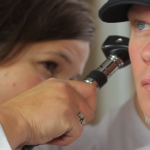In the realm of occupational health, the terms “DOT physical” and “non-DOT physical” frequently arise, particularly in industries involving transportation and safety-sensitive positions. It’s crucial to understand the distinctions between a DOT physical vs non-DOT physical exams to ensure compliance with regulations and to promote workplace safety and employee health. This guide delves into the intricacies of DOT physicals and non-DOT physicals, outlining their purposes, requirements, and differences.
What is a DOT Physical?
A DOT physical, mandated by the Department of Transportation (DOT), is a specialized medical examination required for commercial vehicle drivers. The primary purpose of a DOT physical is to ensure that drivers are physically and mentally fit to perform their job duties safely. This examination is essential for maintaining road safety and minimizing potential health risks that could lead to accidents.
Key Components of a DOT Physical
A DOT physical exam includes a thorough review of the driver’s medical history and an assessment of various health parameters. Here are the main elements:
- Medical History Review: A comprehensive review of the driver’s medical history to identify any underlying medical conditions that may affect their ability to drive safely.
- Vital Signs: Measurement of vital signs, including blood pressure and heart rate, to assess cardiovascular health.
- Vision and Hearing Tests: Evaluation of vision and hearing capabilities to ensure the driver meets the required standards for operating a commercial vehicle.
- Urinalysis: A urinalysis to detect any medical conditions that could impair driving abilities.
- Physical Examination: A complete physical examination to check for any physical impairments or conditions that may affect the driver’s performance.
- Neurological Health: Assessment of neurological health to identify any conditions that could impact driving safety.
The DOT physical meaning extends beyond merely passing a test; it’s about ensuring the driver can perform their job safely and effectively.
What is a Non-DOT Physical?

In contrast to DOT physicals, non-DOT physicals are not regulated by the Department of Transportation but are typically conducted by various employers to ensure the health and fitness of their employees. These exams are often required for roles that do not involve commercial driving but still demand a certain level of physical capability and health.
Key Components of a Non-DOT Physical
Non-DOT physical exams can vary significantly depending on the employer and the specific job requirements. However, they generally include the following elements:
- Medical History: A review of the employee’s medical history to identify any potential health risks.
- Vital Signs: Measurement of vital signs such as blood pressure, heart rate, and respiratory rate.
- Physical Examination: A thorough physical examination to assess the overall health and physical fitness of the employee.
- Hearing and Vision Tests: Evaluation of hearing and vision to ensure they meet the necessary standards for the job.
- Additional Tests: Depending on the job, additional tests such as drug testing, lung function tests, or assessments for hazardous materials handling may be included.
Differences Between A DOT Physical vs Non-DOT Physical
The primary difference between DOT physicals and non-DOT physicals lies in the regulatory requirements and the specific job duties they address. DOT physicals are strictly regulated by federal guidelines and are required for commercial drivers, whereas non-DOT physicals are employer-specific and cater to a broader range of job roles.
- Regulatory Requirements: DOT physicals adhere to federal regulations set by the Department of Transportation, while non-DOT physicals follow employer-specific guidelines.
- Job Duties: DOT physicals are essential for ensuring that commercial drivers can safely perform their job duties. Non-DOT physicals are tailored to meet the specific job requirements of various other roles, such as construction workers, office employees, and more.
- Scope of Examination: DOT physical exams have a standardized set of tests and criteria, while non-DOT physical exams can be customized based on the employer’s needs.
To schedule your DOT medical card appointment, contact us at 704-544-2494. Visit the Charlotte DOT Exam Center, located at 8415 Pineville-Matthews Road, Charlotte, NC 28226. Our certified medical examiners are available Monday through Friday from 9 AM to 5 PM, and Saturday from 9 AM to 12 PM. For just $70.00, your exam includes the mandatory urinalysis and a durable laminated card upon passing. Call now to secure your spot!
FAQs
What is the difference between a regular physical and a DOT physical?
A regular physical exam assesses overall health and wellness, while a DOT physical specifically evaluates a commercial driver’s fitness to perform job duties safely.
What is a non-DOT examination?
A non-DOT examination is a medical exam conducted by employers for roles that do not involve commercial driving, ensuring employees are fit for their specific job requirements.
How do you get around a DOT physical?
It’s not advisable to “get around” a DOT physical as it is a legal requirement for commercial drivers. Ensuring health and fitness is paramount for safety.
What does DOT stand for in a physical exam?
DOT stands for the Department of Transportation, which mandates physical exams for commercial drivers.
What is the difference between a DOT and a non-DOT physical?
DOT physicals are federally regulated and required for commercial drivers, while non-DOT physicals are employer-specific and cater to various job roles.
What is a non-DOT physical in Texas?
A non-DOT physical in Texas follows the same principles as in other states, focusing on employer-specific health and fitness requirements.
What is the difference between a DOT test and a non-DOT test?
DOT tests are standardized and federally regulated, while non-DOT tests vary based on employer requirements and job-specific needs.
What does a non-DOT test consist of?
A non-DOT test typically includes a medical history review, vital signs measurement, physical examination, and any additional tests required by the employer.
What happens if you fail a non-DOT drug test?
Failing a non-DOT drug test can result in disciplinary action from the employer, including potential job termination.
Can you fail a pre-employment physical for high blood pressure?
Yes, if high blood pressure poses a significant risk to job performance and safety, it can result in failing a pre-employment physical.
What does a physical consist of?
A physical exam includes a medical history review, vital signs measurement, physical examination, vision and hearing tests, and any additional tests required by the specific exam type.

I am the administrator for the Charlotte DOT Exam facility, located in Charlotte NC. I oversee the facility services providing DOT exams in accordance with the standards of the FMCSA. We also provide DOT drug testing with MRO support when required. Drug testing can also be done for non-DOT exams such as pre-employment. In order to minimize wait times, I always encourage our clients to contact us first and make an appointment.
I would also suggest that each individual wanting to test for the CDL health card read the article “Preparing For Your DOT Exam” as it lists several things to bring to the test, such as CPAP usage reports and medicine lists.


